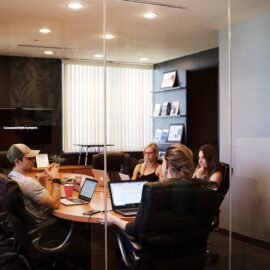

This article is an excerpt from the Shortform book guide to "The E-Myth Revisited" by Michael E. Gerber. Shortform has the world's best summaries and analyses of books you should be reading.
Like this article? Sign up for a free trial here .
Are you facing a business crisis? Do you feel like you’re losing control?
In The E-Myth Revisited, Michael E. Gerber shares three actions you should avoid in a business crisis. Then he offers a solution: get out of your comfort zone and take on new identities by developing new skills. As your business grows, you need to grow.
Read more to learn what to do (and what not to do) in a business crisis.
What You Shouldn’t Do in a Business Crisis
In the adolescent (intermediate) phase of business growth, your business always reaches a point beyond your comfort zone, at which you begin to feel you’re losing control. Business owners typically go one of three directions at this point: they shrink the business in size (return to the infancy stage), keep growing willy-nilly (go all out), or go into survival mode.
Go Back to Square One
When you have a technician mindset and hit the crisis point, you’ll be inclined to try to go back to the way things used to be, when having fewer customers, fewer bills, and fewer employees meant things were less complicated. You can get rid of some of the problems of growth this way, but when you go back to doing everything yourself, you’ll soon be overloaded again. Things will deteriorate and, like 400,000 small business owners in the U.S. each year, you’ll throw in the towel.
Grow Willy-Nilly
An alternative to shrinking during a business crisis is to go all out as fast and as far as you can. This is a common approach in the technology sector. Tech companies started by technician/owners who have a good idea tend to stay focused on what they’re producing, rather than on running a business. This looks deceptively promising — they usually build momentum, until they crash due to a weak underlying business foundation.
If you go all out, your problems will be magnified by the pace of growth — demand ultimately will exceed your production capacity — and your business will collapse. A brilliant idea and rapid growth by themselves can’t sustain a business, although you may be able to walk away with some cash.
Enter Survival Mode
The third possibility in a business crisis, also unpalatable, is that you soldier on and survive for a time by pushing yourself and your employees to the extreme. But when you become consumed by your business, you’ll inevitably reach a personal breaking point.
What You Should Do in a Business Crisis
Business owners have a better alternative to shrinking, growing uncontrollably, or entering survival mode: productive change. This requires leaving your comfort zone and taking on new identities (manager and entrepreneur) by developing new skills.
Businesses are destined to grow. What usually holds them back are the owner’s limitations in skill, knowledge, and, most importantly, passion for learning and for the business. As your business grows, you need to grow personally.
When you decide to shrink or go back to square one, you’re reacting to changes you could have anticipated and planned for, had you learned business skills to accompany your technical skills. For instance, you could have predicted that customers would like your product and, therefore, that your business would grow. You could have predicted the result of failing to be involved in the work of your employees. You could have predicted that a growing business would require developing new skills. Your job is larger than that of a technician — it’s to prepare yourself to grow your business.
You do this by understanding business processes, having clear objectives for yourself and your business, and developing a plan for getting there. This includes deciding at the outset how you want your business to grow by answering questions like:
- “What are my goals, and how quickly do I plan to reach them?”
- “How much capital will I need to reach my goals?”
- “How many people do I need to hire, and what work will they do?”
- “How much space will I need in six months? In two years? In 10 years?”
By following the right process, you can build a business that works because of the way you designed it, not because of what you do each day to keep it going. In other words, you can build a business that works without you rather than one that enslaves you.
A business crisis doesn’t have to be the end if you face it with a mindset of personal growth and adaptability.

———End of Preview———
Like what you just read? Read the rest of the world's best book summary and analysis of Michael E. Gerber's "The E-Myth Revisited" at Shortform .
Here's what you'll find in our full The E-Myth Revisited summary :
- Why so many new business owners fail
- Why how you produce something is more important than what you produce
- The 7 components that you as an owner must work through






